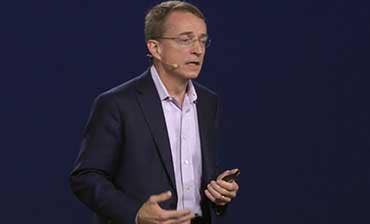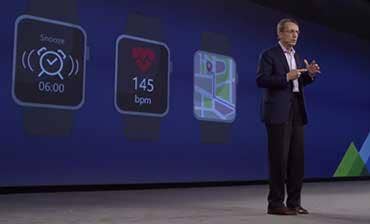Pat Gelsinger: VMware Opens Up Tech Partners To Expand Cloud Capabilities

VMware on Tuesday unveiled partnerships aimed at further integrating its virtualization and cloud technology with that of several tech industry heavyweights including AWS, Google, Pivotal, and Dell EMC.
Those partnerships include supporting Google Chromebooks with VMware's WorkSpace ONE endpoint management technology, a virtual desktop infrastructure partnership with Dell EMC, a move to make it easy to run VMware technologies on Amazon Web Services, and further integration of its virtualization and cloud capabilities with development technology from Pivotal.
VMware also unveiled VMware Pulse IoT Center to enhance the management and security of IoT edge devices.
[Related: VMware Cloud For AWS: The Tech Groundwork Is Laid, Partners Look At How To Adopt]
VMware CEO Pat Gelsinger used his Tuesday keynote at the Dell EMC World conference to debut the new technologies.
Gelsinger also oversaw the first public demonstration of VMware Cloud on AWS, the recently unveiled strategic partnership under which customers will be able to run VMware vSphere-based applications across private, hybrid, and AWS public cloud environments using their existing VMware software and tools.
Gelsinger said IoT, which features an increasing number of devices sending data to a central location, has become the force that is taking the industry back towards the next centralization of IT. "IoT will be the strategy driving us back to the edge. … And as a result, we have to rebuild the edge," he said.
Dell EMC is building multiple platforms to meet the increasing requirements of IoT at the edge, especially in terms of security, Gelsinger said. "Important: Lots of devices," he said. "Most importantly, every one of those devices has to be protected."
VMware Pulse IoT Center, the first in a new family of products designed to tackle IoT issues, is focused on the management, monitoring, and security of IoT devices via IoT gateways. It will be a part of VMware's software-defined data center initiatives, Gelsinger said.
This type of solution is a critical part of IoT. "[These devices] have to be connected, secured, and managed," he said.
Gelsinger also introduced several additions to VMware's cloud strategy, which he said boils down to any device with any application on any cloud.

The ability to run any application on any device is important as consumers in the Apple generation download any application to their devices and expect them to work, Gelsinger said.
However, enterprises have to manage both legacy and modern applications. "How do we stitch all of that together?" he said.
VMware is doing that with AirWatch and WorkSpace ONE. WorkSpace ONE in particular combines mobile device management and virtual desktop infrastructure with what Gelsinger termed "consumer simple, enterprise secure."
The latest move along those lines is the partnership with Google, under which Google Chromebooks can be deployed and secured via WorkSpace ONE, making it easier for enterprises to adopt the devices for their users, Gelsinger said.
Gelsinger also unveiled VDI Complete, an end-to-end virtual desktop infrastructure offering that combines virtual desktops with VMware's VxRail hyper-converged infrastructure technology.
"We're bringing the end points and the infrastructure into one complete solution," he said.
VMware's cloud strategy is also aimed at embracing all the cloud platforms customers use, including those which may not natively embrace VMware technology, as a way to stretch their private clouds to public clouds, Gelsinger said.
One of the most visible results of that strategy was VMware Cloud on AWS. Introduced last October, VMware Cloud on AWS is aimed at letting customers run applications across VMware vSphere-based private, public and hybrid cloud environments using their existing VMware software and tools for a full range of storage, database, analytics and other services.
Gelsinger brought Purnima Padmanabhan, vice president of product management within the cloud management business unit at VMware, on-stage to give the first public demonstration of VMware Cloud on AWS.
Padmanabhan first demonstrated how she could set up a software-defined data center on AWS quickly with only three clicks. She then used vRealize Automation with an existing catalog of apps to quickly provision a WordPress blog on AWS with all the required policies and pricing, and said it would take about 45 seconds to add Dell EMC backup and recovery capabilities.
Another important part of VMware's cloud strategy is the ability to run any application on any cloud, Gelsinger said. Many applications, especially those built in containers, are not easily moved to production environments, which is where Pivotal comes in.
To emphasize that point, Gelsinger brought Pivotal President Bill Cook on stage, where Cook said it is important to more closely tie cloud platforms like VMware to developers.
VMware, with its industry-leading infrastructure tools, and Pivotal, with its industry-leading developer tools, together can help developers find ways to increase their efficiency, Cook said. "Certainly getting those two groups together has been a challenge," he said.
The fact that VMware is so open to partnering on the cloud reflects the fact that VMware knows it is part of a complex ecosystem, said Scott Miller, data center director at World Wide Technology, a St. Louis, Mo.-based solution provider and long-time VMware channel partner.
"IoT, mobile device management, end-user computing, software defined data center, dev-ops is making for a very complicated stack," Miller told CRN. "The more VMware and its partners build end-to-end solutions, the more they sell. And that means more solutions their channel partners can help sell."